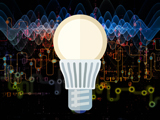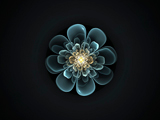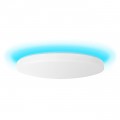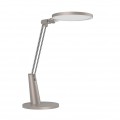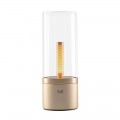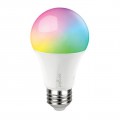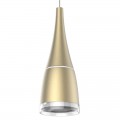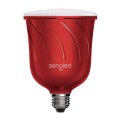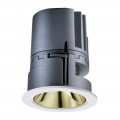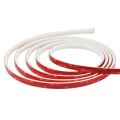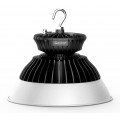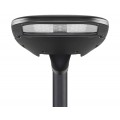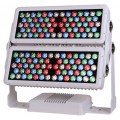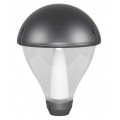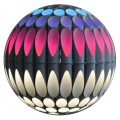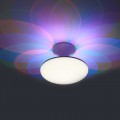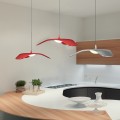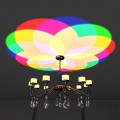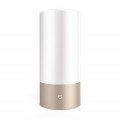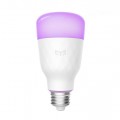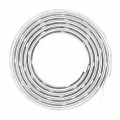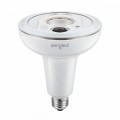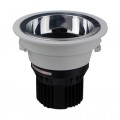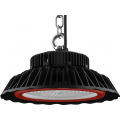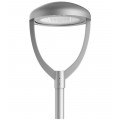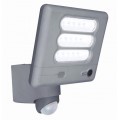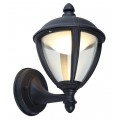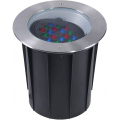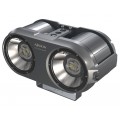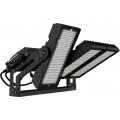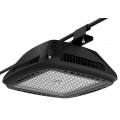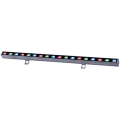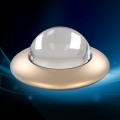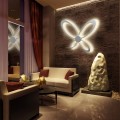A light-emitting diode (LED) is a semiconductor diode that emits light when electrically biased. Light emitting diodes typically include one or more active layers of semiconductor material sandwiched between oppositely doped layers and convert electric power to light as a result of injection electroluminescence within a semiconductor chip and may have an additional wavelength converter, which partially or completely converts the electroluminescence due to photoluminescence in phosphors. When a bias is applied over the doped layers, holes and electrons are injected into the active layer where they recombine to produce light. Light is emitted from the active layer and from all surfaces of the LED. LEDs represent an appealing alternative to incandescent light bulbs in illumination devices attributable to their smaller form factor, lower energy consumption, longer operational lifetime, and improved mechanical robustness.
LED chips, which are a type of semiconductor products, are susceptible to performance degradation, or aging, if exposed for a long period in an atmosphere of humidity or chemical. The efficiency of a light emitting diode can be characterized in various manners, but in most cases is established by several factors which in practice become cumulative in their positive or negative aspects. LED packaging basically provides mechanical, electrical, thermal, and optical supports to LED chips. Design for packaged white LEDs is a lot more complicated and requires further consideration of color temperature, color rendering index, phosphor, etc. The luminance provided by light emitting diodes varies according to a couple of factors such as internal quantum efficiency, which quantifies the fraction of injected carriers converted to photons, and extraction efficiency, which quantifies the fraction of photons successfully extracted from the light emitting diode. Heat dissipation and light extraction should be simultaneously considered for LED packaging. The heat generated by an LED chip, if not well dissipated, can deteriorate the LED chip, reduce its lifespan, and downgrade its reliability. Optical design, such as the way to extract and direct the light into a preferable angle or distribution, also plays a huge role for LED packaging.
A typical high efficiency LED consists of an LED chip fitted to an LED package and encapsulated by a transparent medium. For typical LEDs it is desirable to work at the highest light emission efficiency, and one way emission efficiency can be measured is by the emission intensity with regards to the input power, or lumens per watt. A good way to maximize emission efficiency is by increasing extraction of light emitted by the active region of LEDs. The efficient extraction of light from LEDs is a major challenge in the fabrication of high efficiency LEDs. LEDs are constructed of a high refractive index semiconductor material. However, a fraction of the light generated by the LED internally reflects from the interfaces with the outside medium (either air or an encapsulant) as a consequence of total internal reflection. This light is known as guided light. Its existence is undesirable to the performance of the LED mainly because it limits light extraction. To achieve high efficiency LEDs, both the internal efficiency and extraction efficiency needs to be improved. Various processes can be employed to extract guided light, which include shaping the LED, or roughening some of the surfaces. Surface texturing raises the light escape probability through providing a varying surface that enables photons multiple opportunities to find an escape cone. Light extraction of LEDs emitting in the visible portion of the spectrum, for example gallium nitride (GaN) LEDs, can be optimized by making use of high reflectivity metallurgies, which are typically mounted to one side of the LED. These approaches are designed for breaking the guided trajectories in an attempt to increase light extraction.
LED performance with regards to efficiency and color stability is very sensitive to temperature increase, and particularly for high temperatures above 80 degree. C. Light emitting diodes are commonly made employing semiconducting material doped with impurities to create a P-N junction. When electrical potential (voltage) is applied to the P-N junction current flows through the junction. Charge-carriers (electrons and holes) flow in the junction. In the event that an electron meets a hole, it falls into a lower energy level, and releases energy in the form of light (photon, radiant energy) and heat (phonon, thermal energy). In many applications, light is the desired form of energy from an LED and heat is certainly not desired. This is because heat frequently causes permanently damages to the LED, degrades LED performance by inflicting decreased light output, and results in a premature device failure. Notwithstanding the impressive improvement in energy efficiency over more traditional light sources, LED light sources still convert between 50 to 80% of the power they are fed into heat. This criticality is especially apparent in high power LED applications. There is an ever growing demand for increasingly brighter LEDs. To make brighter LEDs, the most obvious technique is to increase the electrical power applied to the LEDs. Although leads to LEDs operating at even greater temperatures. Consequently, adequate heat-sinking or cooling is essential to maintain a long lifetime for the LED, which is especially critical in applications where the LED must operate over a wide range of temperatures.
In general, the performance of LEDs are interdependent upon the thermal, optical, and control system applied. The goal in efficient lighting design is to optimize the amount of electrical power that is converted into light energy. The properties of an LED, such as chromaticity and luminous efficiency, are drastically impacted by the temperature of the device and range widely between devices due to manufacturing variability. Lamps may additionally suffer further optical losses when integrated into a fixture. Additional optical losses may also take place in lamps comprising a plurality of individual LEDs as a result of increased etendue of the optical system. As is known, etendue describes how spread out light is in a specific medium over a given area and a solid angle. The relatively narrow spectral distribution of an LED demands that many primaries be combined to produce a broad spectral illumination for high color rendering index and wide color gamut. The inherent drawbacks of LEDs are exaggerated for applications that require high luminous density and output, uniform chromaticity and beam profile, and consistency between sources over their lifetimes. To understand the performance of LEDs in regards to general illuminance applications, it is very important to take into account the lumen output, color quality, system efficiency, thermal management and product life of the LED luminaire.












